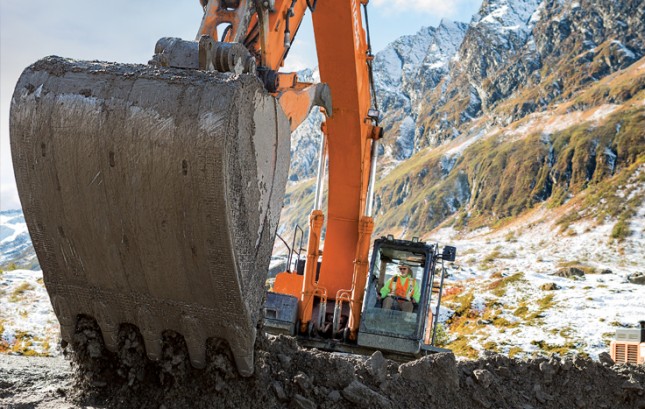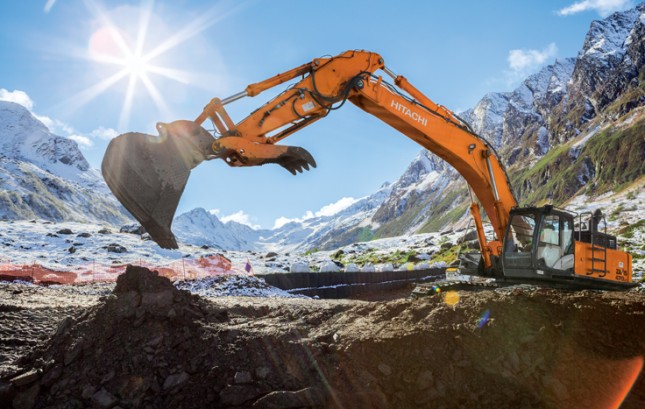In the Chugach Mountains, about 1,310 feet above the city of Valdez, Alaska, excavators are hard at work on a hydroelectric site that will help deliver sustainable solutions for the area.
Four ZX470LC-5 excavators, a ZX50U-5 and a ZX85USB-5 are moving earth on the Allison Creek Hydroelectric project, which is spearheaded by McMillen Jacobs. The environmental, engineering and construction firm provides comprehensive technical capabilities on a wide range of water resource, hydropower, dams, transportation and tunnel projects, using design-bid-build and design-build delivery methods.
McMillen Jacobs’ excavators are moving about 400,000 tons of earth for the project, which primarily includes creating a structure to divert water from Allison Creek into a penstock that will carry the water 7,000 feet down a mountain to a self-running powerhouse capable of producing 6.5 MW of electricity per hour for consumers.

Matching Equipment to the Project
Choosing equipment that’s designed well and customized for the application is critical for success on any project. However, it becomes even more important when working in tough terrain and conditions.
As a former operator, McMillen Jacobs Project Superintendent Cody Wilson knows how equipment can make or break project progress.
“It’s little things—like if windows fog up because of vent placement—that really matter,” Wilson said. “When your operators are comfortable, they’re happy and they can work.”
Each of the four excavators is outfitted with single steel grousers for added traction in the mountainous terrain. Along with other tasks, these excavators are hammering rock, digging dirt and placing 171 sections of approximately 40-foot pipe, which weigh about 9,600 pounds each, for the penstock.
McMillen Jacobs used the ZX50U-5 to remove about 1,000 cubic yards of shot rock from the tunnel sill in order to bury the penstock pipe below grade of the 768-foot access tunnel. Wilson said the size of this tiny titan was critical for completion of the penstock work inside the 16-foot-wide by 16-foot-tall tunnel.
“It was the biggest machine we could fit in the tunnel that could turn around,” Wilson said. “The zero tail swing was crucial.”

Supporting Productivity
In addition to site work and construction management for the project, McMillen Jacobs is also managing more than 15 environmental plans—from avian protection and water quality sampling to erosion control and bear safety. Yes, bears. It’s not unusual to come across bears on jobsites in Alaska.
Along with bears, it’s also not unusual to face the challenge of remote site locations. McMillen Jacobs keeps productivity on track with on-site support as well as equipment dealer support from Construction Machinery Industrial (CMI).
“Working in Alaska is a challenge,” said Travis Shelton, McMillen Jacobs project manager on the Allison Creek Hydroelectric Project. “We keep a full-time mechanic on site, and the CMI guys are good about responding with product support.”
Wilson said he’ll miss taking in the panoramic views every day on site, but he’s looking forward to seeing the finished project. Estimated to be completed this year, the project is expected to save burning 700,000 gallons of fossil fuel and eliminate 12,000 tons of carbon dioxide annually.
Allison Creek Hydroelectric Project Stats
- Powerhouse access road
- 0.5-mile lower-access road
- Access tunnel: 768 feet long; 16 feet wide and 16 feet tall
- 2.1-mile upper-access road
- In-stream diversion and intake structure requiring approximately 1,200 cubic yards of concrete
- 7,000 feet of 36-inch and 40-inch penstock pipe
- 60-foot by 70-foot powerhouse building with a 70-foot-long concrete tailrace
- 6.5 MW turbine package
- New substation
- 3.5 miiles of high voltage transmission line connecting new power generated from Allison Creek to existing Dayville Substation
